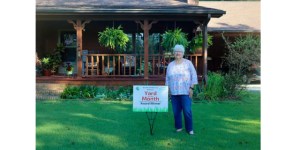Keeping Fit: ‘Weak things break’: Keeping your body resilient to injury through exercise
Published 11:00 am Sunday, November 19, 2023

- Tucker Gregg
We’ve all heard the age-old story of the three little pigs. What happened to the two pigs who built their houses out of straw and sticks versus the pig who built his house out of bricks? Straw and sticks were blown away and the brick house stood firm.
That is exactly how we should look at our bodies. It’s no secret that with age our bodies spiral downward, our muscles atrophy, our bone mass decreases and unfortunate accidents can cause pretty serious injuries. As said by strength and conditioning coach Louie Simmons, “Weak things break.” Let’s dive into how we can lay some bricks and build a foundation to stay resilient for life.
Trending
Age of decline
Unfortunately the clock keeps ticking, our bodies keep withering, and if we don’t use it, we’ll lose it. Certain conditions can come with age that put us in great risk of injury, one being sarcopenia, which is the medical term for frailty, the condition in which our muscle mass declines with age.
For example, after age 30 you begin to lose as much as 3% to 5% of your muscle tissue per decade and up to 30% in a lifetime, according to Harvard University. This is highly associated with falls that can lead to injury.
A 2015 report from the American Society for Bone and Mineral Research found that people with sarcopenia had 2.3 times the risk of having a low-trauma fracture from a fall, such as a broken hip, collarbone, leg, arm or wrist. The good news is this is not inevitable. We can preserve our muscle and even build it.
“It takes work, dedication and a plan, but it is never too late to rebuild muscle and maintain it,” said Dr. Thomas W. Storer, director of the exercise physiology and physical function lab at Harvard-affiliated Brigham and Women’s Hospital. There is only one proven strategy to battle against muscle loss and that is progressive resistance training.
The best method
Trending
It’s pretty common knowledge that we should train each muscle group one to three times a week but let’s look into this more in depth and talk about some of the best exercises that can combat muscle loss and keep us on our feet.
Compound movements are your best way to go. Compound exercises involve multiple joints and muscle groups working together to move resistance. They are known to improve coordination, burn more calories, improve bone density and encourage more helpful hormones to release such as growth hormone. Since most injuries occur due to falling, it makes sense to prioritize our leg and core muscles for balance and to keep them strong. There are many different exercises to choose from but here are my top three lower-body movements to help you stay sturdy.
The squat
If I were to do one exercise for the rest of my life it would be the squat. The squat is a basic human movement that seems to diminish quicker than any other movement as we age.
My reason for selecting the squat is because there are many different variations that require and improve mobility, and it involves a tremendous amount of trunk control. Therefore it is going to be one of your best bets for improving leg strength and preventing a fall. and if a fall does happen, it can give you the strength to prevent breakage and be able to get back up.
To start, the movement can be as simple as squatting down to sit in a chair and standing back up. With practice you’ll be able to move on from the chair and squat freely. The variation of squats is very broad and they all have their similarities and different benefits so find what works best for you.
One-legged exercise
Being strong on two legs is great but being strong on one is even better. To complement the squat, add a split squat or a lunge to your routine as you gain strength and ability. These are unilateral exercises which help greatly with balance.
A unilateral movement involves training one limb or side at a time. Doing so requires a lot more stability than bilateral movements like the squat, thus improving balance. It also allows you to work on certain muscle and strength imbalances in case, like most people, you have one leg that is a bit stronger than the other. Just like the squat, there are many different variations of one-legged movements to choose from.
The deadlift
Last but not least we have the Romanian deadlift. This is a hip exercise that can be executed with a barbell, dumbbell, kettlebell or whatever you like best. This is one of the best exercises for strengthening the muscles on your back side (back, hamstrings, glutes and calves). We tend to slouch as we get older, and having a weak back side is no help. Slouching and poor posture is a dramatic risk factor for falling which is obviously what we don’t want.
Bottom line
Remember, nothing will eliminate all risk factors of falling and injury, but we can reduce these risk factors. The best thing to do is keep it simple and focus on improving. These might be very simple and basic exercises but they are your bread and butter to having a strong base. Add these into your routine and you’ll notice results fairly quickly. Over time as you progress you’ll be stronger, more balanced and resilient to injury than you would’ve ever thought. So make these leg exercises your friend and don’t ever skip out on them.
Tucker Gregg is a fitness consultant at the Bradley Wellness Center.





